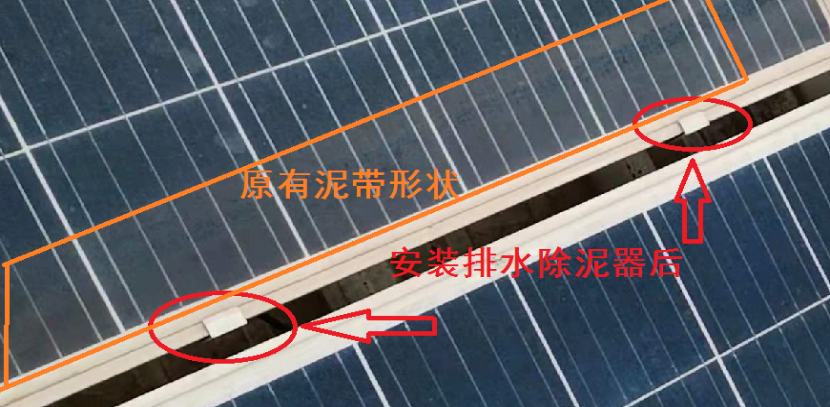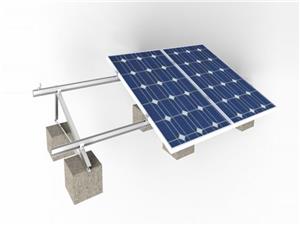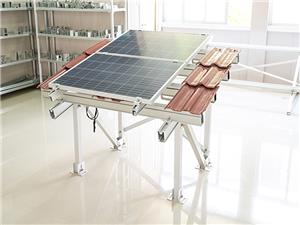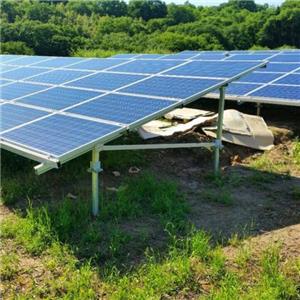6 key factors to consider when investing in rooftop solar photovoltaic power plants
6 key factors to consider when investing in rooftop solar photovoltaic power plants
Most household and industrial and commercial photovoltaics install photovoltaic modules on the roof, which not only helps owners save electricity bills, but also optimizes the use of roof space and cools the roof.
This article will discuss some of the most important things you must know about installing solar panels on flat roofs.
Key 1: Which type of installation is used
Different roof installation methods of photovoltaic modules are different, common installation methods include additional type, ballast type and pile foundation type.
If the roof belongs to the color steel tile type, the additional type is generally considered, and the components are directly tiled on the color steel tile, especially the general color steel tile roof does not have a parapet, and the tiled type has the best windproof effect and the safest; In addition, the color steel tile roof also has a certain inclination angle. Although it may not be the best inclination angle for photovoltaic power generation, the transformation cost caused by increasing the inclination angle also needs to be considered comprehensively.
For the cement roof, it is usually flat, and the common installation methods are ballast type and concrete foundation pile type, as shown in the figure above.
In many cases, building owners are not allowed to drill holes in the concrete flat roof. On the one hand, they are worried about the strength of the old building, or do not want to change the waterproof performance of the roof. This is the reason for choosing ballast type or concrete foundation installation.
Since the ballast type is not anchored to the roof, windproof treatment can be considered on the side, especially for cement roofs without parapets.
The main purpose of the concrete foundation is to ensure that the support system remains intact even during stormy seasons. It ensures a good installation without causing roof leaks, can also improve the efficiency of solar cell modules, and reduce the parapet's shielding from the sun.
Key 2. Flat roof does not mean tile installation
Installing photovoltaic modules on a flat roof by tiling seems to be the most taken for granted. Not only can the installation volume/area be maximized, it is also possible to use photovoltaics as a roof top to increase the space area.
But in fact, installing photovoltaics on a flat roof does not mean that you should also set its inclination to 0 degrees. We need to consider many factors. Flat installation should be avoided, including:
l Tiled components are easy to accumulate dust, which may cause 10% or even 30% of the power generation loss;
l It is more inconvenient to clean, and the stagnant water is not easy to flow out;
l Compared with inclined installation, the power generation will be reduced;
l The payback period will be longer;
l May not rely on natural rainfall to remove dust accumulation;
Oblique installation and purely tiled photovoltaic arrays have obvious differences in power generation. Through simulation of an 11.2kWp solar system, the inclination angles are 10 degrees, 5 degrees and 0 degrees, respectively.
The simulation results show that if the inclination angle is 0 degrees, the 11.2kWp system annual power generation is about 13,480.3kWh, and at a 5 degrees inclination angle, the annual power generation of the system reaches 14,066.9kWh. In fact, when the inclination angle is 10 degrees, the annual power generation of the system reaches 14,520kWh.
It can be seen from the results that for every 5 degree increase, the system will increase the power generation capacity of 500kWh per year (after 15 degrees, the increase will be significantly reduced, and it will be even lower after the optimal inclination angle is exceeded). Moreover, the above simulations have not taken into account the loss of power generation due to dust accumulation during low-tilt installation.
According to the communication between "Global Photovoltaics" and industry experts, it is recommended that if you are unwilling to install with the best inclination angle, the installation inclination angle should be as high as possible. If it must be tiled, it is recommended to also design the inclination angle between 5-10 degrees. For a flat roof, an angle of 5-10 degrees is already flat enough, and for a color steel tile roof, there is generally an angle of more than 3 degrees. Compared with the additional cost of increasing the inclination angle, let it go. It is also a good choice to follow the trend.
Key 3. Flat roof installation must consider wind speed
In the design phase of the solar system, the maximum wind speed that may occur in the local area must be considered, especially in areas where the wind speed exceeds 180 kilometers per hour.
Not once in five years, once in ten years, the life of the photovoltaic system is 25 years, you must consider the once in 50 years!
The typhoon that occurred in Nantong, Jiangsu Province at the end of April 2021 is enough to explain everything. With the improvement of building quality, for the buildings in Nantong area, almost no one will give too much consideration to the typhoon disasters that often occurred 30 years ago. After all, Nantong Typhoons in the area can also have some impact on the squares, thatched houses, and greenhouses in the past.
However, at the end of April this year, the strong wind that occurred in the solar photovoltaic and solar water heaters on the roof to the ground. During the typhoon, more than a dozen people were killed. It is no exaggeration to happen once in 50 years.
Ordinary flat-roof solar power generation systems can withstand wind speeds of 160 km/h (Thirteenth Typhoon), but if there is no parapet to block the wind, no wind protection is considered between the arrays, and the instantaneous wind speed caused by the airflow in a local area will far exceed the actual speed. Wind speed.
At this time, the selection of brackets, structural design, ballast or concrete foundation strength design must rely on the recommendations of professional organizations. Even the tiled roofs of color steel tiles must be scientifically analyzed.
Key 4. Water leakage risk of flat roof installation
Standing water is common on flat roofs. Because the roof is flat, there is nowhere for water to go, or the drainage slows down, and the time to stay on the roof will be longer. Therefore, any cracks and holes on the roof will become places for stagnant water.
At this time, the flat roof with the photovoltaic system installed, due to the damage of the waterproof layer that may be caused by the installation of the bracket and the installation of the concrete pile foundation, becomes the biggest water leakage risk of the flat roof photovoltaic.
If it is a color steel tile roof, it is better to install with a fixture than to make a hole on the color steel tile; if the color steel tile is not suitable for connection with a fixture, the use of structural adhesive bonding is also an option. Zhejiang Silicone has a related solution. Solution; if you have to punch holes, you need to make sure that all holes are properly sealed for waterproofing.
Key 5. Need to consider mechanical units on flat roofs
One of the challenges of designing and installing photovoltaics on cement flat roofs is the various mechanical devices on the roof of existing buildings, such as outdoor air conditioning units, drain pipes, exhaust fans, ventilation facilities, water tanks, railings, roof structures, and HVAC systems And water pipes and so on.
These existing equipment not only affect the layout of the rooftop photovoltaic, the spacing and arrangement of the system brackets, but also may shade the photovoltaic array, or affect future operation and maintenance.
Some designers will consider installing photovoltaics above these facilities to shield the facilities from wind and rain, but another problem that this brings is the high design requirements and windproof requirements, as well as the difficulty of operation and maintenance.
For rooftop facilities, the design can only be carried out in accordance with local conditions, but this is an unavoidable issue for rooftop photovoltaics and must be paid attention to.
Key 6. Additional issuance of roof tiles
Generally, there is no flat installation with an absolute angle of 0 degrees, but a low inclination angle is indeed an unavoidable problem. Even cement roofs will have such a demand. The roof of Wuxi City is a typical application of installing photovoltaic greenhouses on cement roofs:

For roof tiled photovoltaics, the best power generation capacity can still be obtained after optimizing the design, which can be done in different ways.
Method 1: Make a certain inclination angle as much as possible under the condition of flat paving, not necessarily the best inclination angle, especially when the inclination angle is greater than 15 degrees, you need to carefully consider the windproof problem of the roof (the greater the inclination angle, the greater the influence of wind ). Usually 5-10 degrees is enough. At the same time face the best orientation.
Method 2: For approximately flat modules with a very low inclination angle, leave a gap between the upper and lower rows of modules so that the water on the surface of the module can flow out of the surface of the module instead of accumulating to the next module. This is an additional requirement for photovoltaic arrays designed as a roof, because the roof is to keep out the rain. You can consider installing drainage channels between the modules to achieve this (this kind of solution is currently common in solar room photovoltaic applications, and industrial and commercial roofs can be used as reference).
The surface of the module in the picture of Wuxi City has obvious traces of mud bands on the lower border, which is the result of the muddy water on the surface of the module being unable to drain off the module surface in time.
Method 3: For low-inclination roof photovoltaic modules, install a product called an automatic drainage desilter to completely eliminate water and dust accumulation on the surface of photovoltaic modules with an inclination angle of 3-15 degrees. Because it is a roof top application, it is inconvenient to climb up to the operation and maintenance in the later period. The selection of the drainage desilter should consider the later operation and maintenance, such as using high-efficiency and long-life materials to avoid plastic products that may need to be replaced after aging in the short term; It is also necessary to consider the corrosion of dissimilar metals between the material and the aluminum frame of the component, and to choose a material that does not affect the surface resistance of the aluminum frame to avoid the risk of component PID.

In short, the six most important things to consider when installing solar panels on flat roofs. The rise in module prices in 2021 will make it difficult for ground-based power stations to achieve parity on the grid. The profitability of the electricity price on the power-consuming side of the industrial and commercial rooftop photovoltaic power station market will be the most important battlefield for photovoltaic in 2021. Knowing the 6 most relevant things about flat roof photovoltaic systems, your return on investment can avoid mistakes and achieve the highest return on investment.




